- Joined
- Feb 11, 2015
- Messages
- 10
I enjoy building Stuart Steam Engine Model kits. But… the fish-belly (FB) connecting rods can be a pain. I’ve used the double taper method before and they turn out fine, but not perfect.
This time I decided to throw together a temporary setup for my 8.5x16 LMS lathe to crank out three 0.250” diameter brass FB connecting rods. The plans called for (2) 3” and (1) 6” long rods. I also decided to test the idea on a piece of aluminum first. Attached are seven photos showing the setup and results.
My scheme was to replace the handle on the compound rest with a stepper motor and to add a turns counter to the longitudinal lead screw. I didn’t motorize the cross slide because I wanted to use it to set the initial position of the tool. Next I programmed an Arduino Microcontroller to count the number of turns of the lead screw and make the stepper motor slowly advance the cutter into the workpiece as the carriage moved along. The result would be a true FB radius along the part.
I struggled with how to calculate the numerical FB profile, but it wasn’t hard once I realized that I only needed to deal with simple chords of circles. BTW, the FB radius of the longer 6” part was over 95”! I loaded the values into the Arduino and it was ready to start making chips.
The Arduino made four passes on each part, with each pass 0.0075” deeper, for a total depth of 0.031”. I started at the center of the workpiece and had the computer cut toward the collet, then flipped the piece around and did the other half. I could have programmed the computer to do the whole length at one time but that would have required a more complicated tool bit and dealing with the backlash problem at the midpoint. It was much simpler to do it one half at a time.
The longitudinal steps were made at 0.026” intervals. I could have programmed more passes and smaller intervals, but at 300 RPM my feet got tired waiting for the multiple passes to finish. Afterwards, a fine needle file easily smoothed out the tiny steps in just a few minutes. Now I’m in the process of learning how to polish them to a mirror finish.
After profiling and smoothing the parts, I restored my lathe to its original state and put the stepper stuff away until the next time I needed it. It’s amazing how helpless I felt with the lathe tied up with the FB setup for almost a week. However, now that I have it all figured out, it will take a lot less time to produce perfect fish-belly parts for my next Stuart model.
Dave
Apple Valley, CA
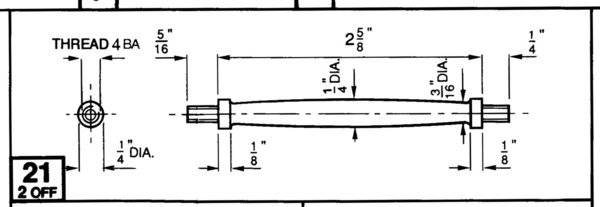
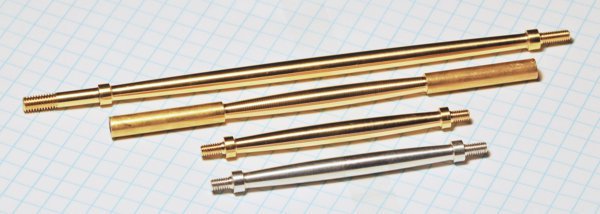
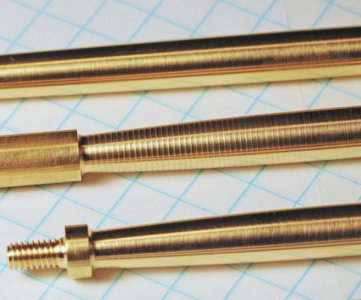
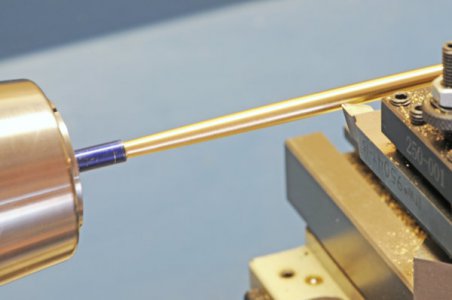
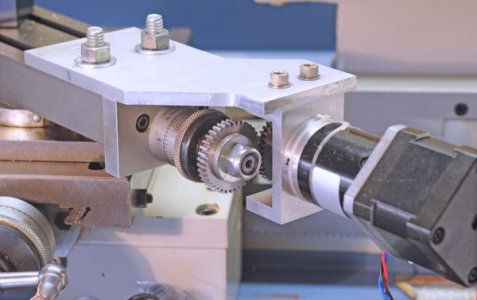
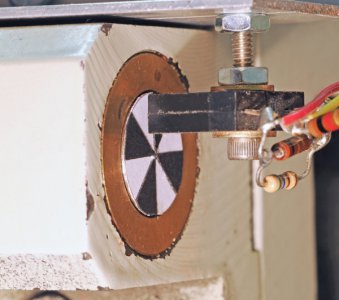
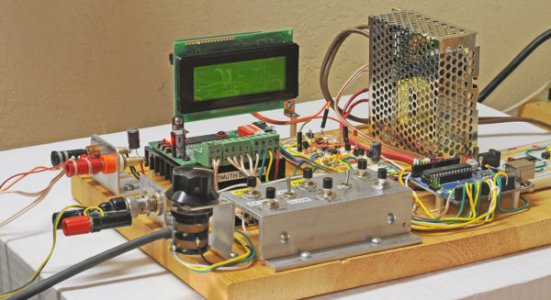
This time I decided to throw together a temporary setup for my 8.5x16 LMS lathe to crank out three 0.250” diameter brass FB connecting rods. The plans called for (2) 3” and (1) 6” long rods. I also decided to test the idea on a piece of aluminum first. Attached are seven photos showing the setup and results.
My scheme was to replace the handle on the compound rest with a stepper motor and to add a turns counter to the longitudinal lead screw. I didn’t motorize the cross slide because I wanted to use it to set the initial position of the tool. Next I programmed an Arduino Microcontroller to count the number of turns of the lead screw and make the stepper motor slowly advance the cutter into the workpiece as the carriage moved along. The result would be a true FB radius along the part.
I struggled with how to calculate the numerical FB profile, but it wasn’t hard once I realized that I only needed to deal with simple chords of circles. BTW, the FB radius of the longer 6” part was over 95”! I loaded the values into the Arduino and it was ready to start making chips.
The Arduino made four passes on each part, with each pass 0.0075” deeper, for a total depth of 0.031”. I started at the center of the workpiece and had the computer cut toward the collet, then flipped the piece around and did the other half. I could have programmed the computer to do the whole length at one time but that would have required a more complicated tool bit and dealing with the backlash problem at the midpoint. It was much simpler to do it one half at a time.
The longitudinal steps were made at 0.026” intervals. I could have programmed more passes and smaller intervals, but at 300 RPM my feet got tired waiting for the multiple passes to finish. Afterwards, a fine needle file easily smoothed out the tiny steps in just a few minutes. Now I’m in the process of learning how to polish them to a mirror finish.
After profiling and smoothing the parts, I restored my lathe to its original state and put the stepper stuff away until the next time I needed it. It’s amazing how helpless I felt with the lathe tied up with the FB setup for almost a week. However, now that I have it all figured out, it will take a lot less time to produce perfect fish-belly parts for my next Stuart model.
Dave
Apple Valley, CA







